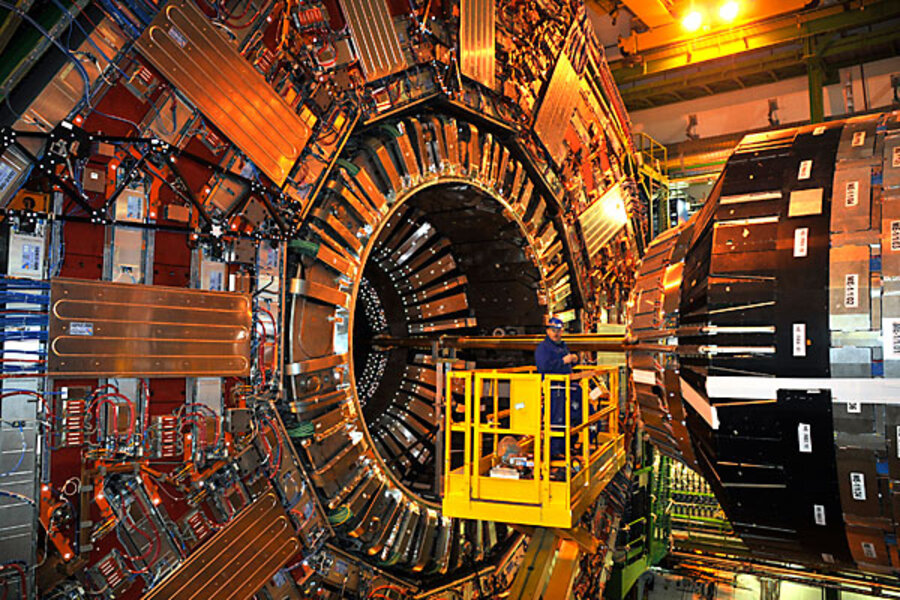CERN particle accelerator set for record energy collisions
If all goes well, Tuesday will mark the dawn of a new era in efforts to create and study forms of matter not seen since the briefest of moments after the universe burst into being in what scientists call the big bang.
Using the Large Hadron Collider (LHC) – a $6 billion underground particle accelerator straddling the Swiss-French border – physicists at the European Organization for Nuclear Research (CERN) will make their first attempts to smack protons together at an energy level unmatched at any other physics lab.
Over the long term, the debris from such collisions are expected to reveal the Higgs boson, a hypothetical subatomic particle thought to be responsible for imparting mass to other particles. Physicists will hunt for evidence of particles associated with dark matter – matter massive enough to act as the scaffold on which the visible universe was built, but sufficiently antisocial so that it rarely interacts with visible matter.
They will also look for evidence that the universe contains several more dimensions than the four that humans experience.
For now, however, researchers will be happy merely to see the first collisions at the new energy level, expected to reach twice as high as the world record. The accelerator set that record before it closed for its scheduled winter shutdown in December.
"Imagine a house with a lot of children on Christmas Eve, and you've pretty much captured the mood," writes Thomas LeCompte in an e-mail exchange from the lab in Geneva.
"Right now we're checking and cross-checking everything as many times as we can, so we're as ready as possible" for Tuesday's attempt, explains Dr. LeCompte, physics coordinator for ATLAS, one of two cathedral-sized detectors along the accelerator's 27-kilometer (17-mile) circumference. The accelerator hosts six experiments overall.
The LHC is designed to accelerate and guide two beams of protons traveling at more than 99.9 percent of the speed of light in opposite directions, in a kind of demolition derby worthy of Pugsley Addams.
Once the beams reach the right speed and intensity, researchers steer them into head-on collisions at junctions inside the hearts of the giant detectors. By analyzing the debris, physicists can determine if they created the particles they are hunting for and estimate several of their traits.
Physicists use units called electron volts to gauge the energy that the particles achieve before they collide. For example, a pair of mosquitoes flying full speed smack together with an energy of about 2 trillion electron volts. Not much happens to the mosquitoes.
At the subatomic level, however, all that energy imposed on vanishingly small particles is a recipe for demolition.
Moreover, since electron volts also can be used to describe a particle's mass, the measure becomes a ready guide for designing an accelerator powerful enough to generate the particles on scientists' wish lists.
For the past week, scientists at the lab have been circulating proton beams at energies of 3.5 trillion electron volts each, which would yield collision energies of 7 trillion electron volts. That's half the energy the accelerator can reach when it's operated at full power – a level thought to correspond to the energy level that the universe experienced when it was one ten-billionth of a second old.
Although hopes are running high for generating collisions on Tuesday, some experienced scientists caution that it may take a few days before the first subatomic mayhem occurs.
“The machine is working well, but we’re still very much in a commissioning phase," said CERN director general Rolf Heuer in a statement last week. "We have to recognize that the first attempt to collide is precisely that. It may take hours or even days to get collisions.”
Indeed, it took three days for the LHC's predecessor, the Large Electron-Positron collider, to record its first collisions once scientists got it running.
Researchers say they expect to run the LHC at 7 electron volts through most of this year before another maintenance shutdown occurs.
Although they will be on the hunt for surprises, much of the science will involve rediscovering already-familiar particles.
This not only helps train the data-analysis software to weed out the known from the unknown later on, researchers explain. It also will help test predictions of how the current zoo of subatomic particles behaves at higher energy levels.





